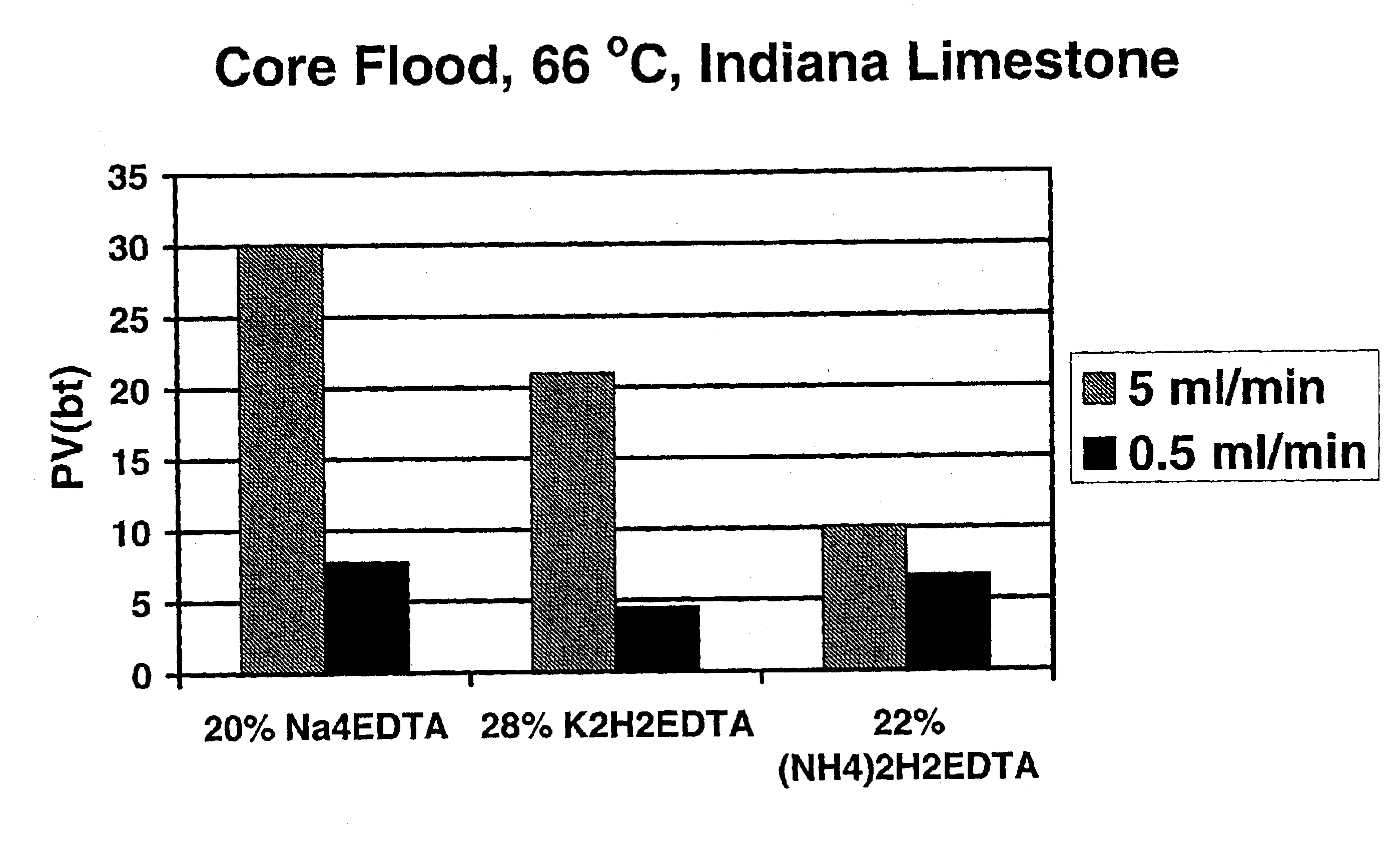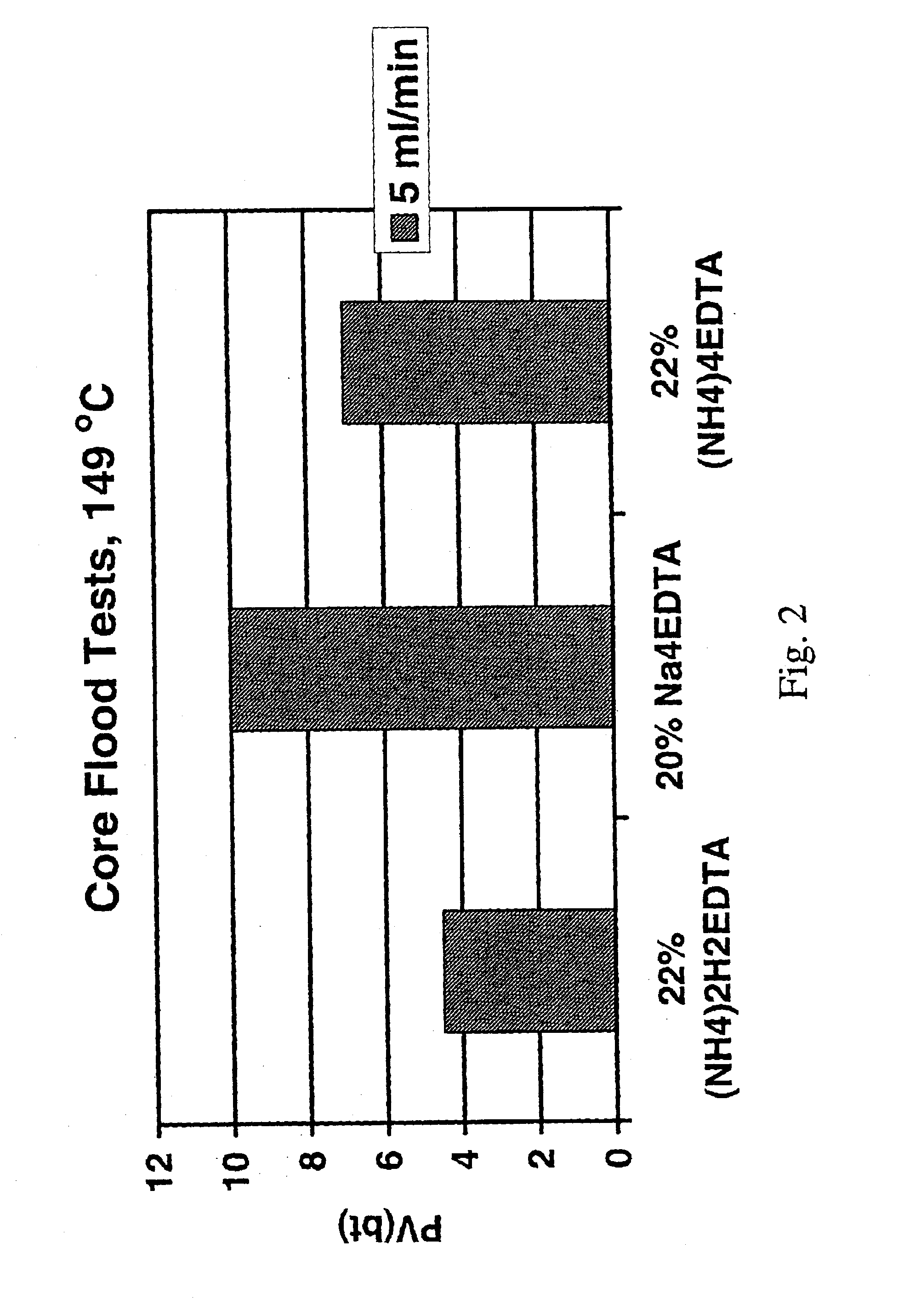Method for treating a subterranean formation
a subterranean formation and subsurface technology, applied in the direction of fluid removal, other chemical processes, wellbore/well accessories, etc., can solve the problems of hydrocarbon flow rate, plugging of some formation pores, and affecting so as to increase the permeability, and increase the permeability of the formation
- Summary
- Abstract
- Description
- Claims
- Application Information
AI Technical Summary
Benefits of technology
Problems solved by technology
Method used
Image
Examples
experiment i
[0025]Dynamic tests were conducted using conventional coreflood test equipment (Larson Engineering) comprising a core holder with Hassler sleeve (approximately one inch in diameter by six inches in length). The methodology followed was analogous to that described in the aforementioned Fredd dissertation; by Fredd, C. N., and Fogler, H. S., “The Influence of Chelating Agents on the Kinetics of Calcite Dissolution”, J. Coll. & Interface. Sci. 204, 187-197 (1998); by Fredd, C. N., and Fogler, H. S., “Alternative Stimulation Fluids and their Impact Carbonate Acidizing”, SPE 31074 (1996); by Fredd, C. N., and Fogler, H. S., “Chelating Agents as Effective Matrix Stimulation Fluids for Carbonates”, SPE 37212 (1997); and by Fred C. N., et al, “The Existence of an Optimum Damköhler Number for Matrix Stimulation of Carbonate Formations”, SPE 38167 (1997).
[0026]In each test, a limestone core (core length 14.0 to 15.4 cm, pore volume 9.6 to 11.4 ml, initial permeability 27 to 77 mD) was loaded...
experiment ii
[0029]A 20 percent solution of tetrasodium ethylenediamine tetraacetate, a 22 percent solution of diammonium ethylenediamine tetraacetate, and a 22 percent solution of tetraammonium ethylenediamine tetraacetate were provided. The procedure followed in the previously described set of tests was repeated, but at a temperature of 149° C., and at a single flow rate of aqueous mixture of 5 ml per minute. The results of these tests are illustrated in the graph of FIG. 2, which clearly demonstrate a lower PVbt for each ammonium ethylenediamine tetraacetate solution, particularly the diammonium ethylenediamine tetraacetate solution.
experiment iii
[0030]Three aqueous mixtures or solutions were provided: a 20 percent mixture of tetrasodium ethylenediamine tetraacetate (which resulted in a pH of about 12), a 28 percent solution of dipotassium ethylenediamine tetraacetate (which resulted in a pH of about 4.5 to 5), and a 21 percent mixture of diammonium ethylenediamine tetraacetate (which resulted in a pH of about 4.5 to 5). Calcium carbonate was stirred into each mixture until saturation was achieved. The amount of calcium carbonate dissolution was then determined by inductively coupled plasma. On the basis of lbs. / 1000 gal. dissolved CaCO3, the 20 percent tetrasodium ethylenediamine tetraacetate mixture dissolved 520 lbs., the 28 percent mixture of dipotassium ethylenediamine tetraacetate dissolved 738 lbs., and the 22 percent mixture of diammonium ethylenediamine tetraacetate dissolved 735 lbs. Accordingly, the dipotassium ethylenediamine tetraacetate and diammonium ethylenediamine tetraacetate solutions were dramatically sup...
PUM
 Login to View More
Login to View More Abstract
Description
Claims
Application Information
 Login to View More
Login to View More - R&D
- Intellectual Property
- Life Sciences
- Materials
- Tech Scout
- Unparalleled Data Quality
- Higher Quality Content
- 60% Fewer Hallucinations
Browse by: Latest US Patents, China's latest patents, Technical Efficacy Thesaurus, Application Domain, Technology Topic, Popular Technical Reports.
© 2025 PatSnap. All rights reserved.Legal|Privacy policy|Modern Slavery Act Transparency Statement|Sitemap|About US| Contact US: help@patsnap.com



